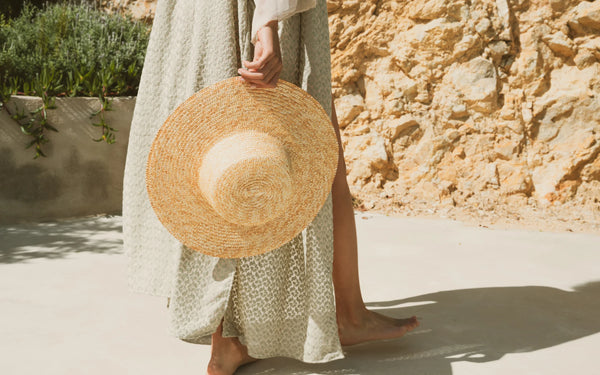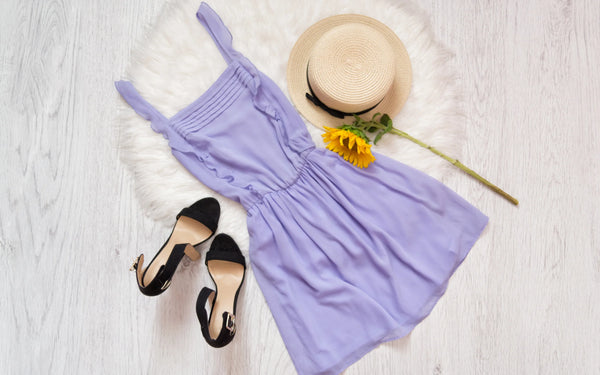Key Takeaways
We recommend cotton, linen, silk, lightweight denim and plant-based fibers like Tencel for summer. These breathable and comfortable materials allow good air circulation and thermal regulation. To avoid: synthetics such as polyester which retain perspiration.
The French brand The Oversized Hoodie® 🇫🇷 is famous for its textile expertise, in particular its collection of high-end, 100% silk products certified Oeko-Tex®Standard 100. Free from toxic and chemical substances, and ecological, the collections silk pillowcase, night mask silk and silk sheets stand out for their incomparable softness and excellent value for money, providing an unrivaled feeling of comfort.
Understanding clothing materials for summer
Summer is just around the corner! With the heatwave periods ahead, it is time to sort through your wardrobe and favor materials suitable for extreme heat.
But which fabric to choose to stay cool when the mercury heats up ? Not all of them offer the same comfort when the sun is strong. To help you make the right choice, find out which are the best fibers to wear in summer.
Cotton: a light and breathable material
Cotton remains a safe bet for the summer season. Coming from the cotton tree, it has many advantages:
-
Its structure in natural fibers gives it great breathability. Air can circulate through the fabric, which prevents sweating and heat.
-
Cotton is a hypoallergenic material that is suitable even for sensitive skin.
-
It is a robust fiber that resists washing well, even at high temperatures. Cotton clothes keep their appearance and softness.
-
Cotton is found in all forms: t-shirts, shirts, dresses, pants, etc. This versatility makes it a must have in your summer wardrobe.
Choose cotton fine and light, such as poplin or voile, for an optimal feeling of freshness. Avoid thick cotton such as fleece, which may make you sweat.
To stay comfortable in the summer heat, it is essential to wear breathable materials. At The Oversized Hoodie®, we recommend cotton, linen and silk for their high sweat absorption capacity.
— Geoffrey, Founder of The Oversized Hoodie®

Also read: Cotton or Polyester ?
Linen: an ideal fabric for summer
Like cotton, linen is one of the plant fibers par excellence for facing the summer heat. Its strengths ?
-
Its structure makes it very airy. Air circulates freely through the fabric, keeping you cool.
-
Linen has absorbent properties that capture moisture and perspiration.
-
It is an anti-bacterial fiber which limits bad odors, even in high heat.
-
We appreciate its soft texture and fluid drape, ideal for floaty dresses and blouses.
Be careful, linen wrinkles easily. You will probably need to iron your clothes often. But this little inconvenience is worth it to stay comfortable all summer.
Silk and satin: elegant fabrics for summer
silk and satin may be delicate materials, but they resist heat surprisingly well. Here are their strong points:
-
Their smooth fibers create a sensation of freshness on the skin.
-
These are fine fabrics which allow good perspiration evacuation.
-
They reflect light and do not become burning in the sun. On the contrary, silk provides a pleasant sensation of cold.
-
Their light shades and bright prints beautifully enhance a summer outfit.
Opt for a little silk dress or a satin top to upgrade your look with elegance. However, be sure to wash them gently to preserve their beauty.
When designing our 100% silk products, we pay particular attention to the choice of materials. Grade 6A silk in 19 or 22 mommes is our fabric of choice for maximum comfort and breathability, even on the hottest days.
— Geoffrey, Founder of The Oversized Hoodie®

Also read: Is silk warm ?
Denim: a daring choice for summer
Jeans aren't just for fall or spring. Provided you choose it carefully, it turns out to be an interesting alternative when temperatures rise.
-
Choose denim stretch, in cotton and elastane. It hugs the silhouette without tightening and hindering air circulation.
-
Aim for a fitted cut, but not too close to the body, to let the skin breathe.
-
Prefer light shades which reflect light and absorb less heat than raw denim.
Paired with a linen tank top or a vaporous blouse, jeans become a timeless and versatile basic for creating chic casual outfits.
Viscose and Tencel: ecological alternatives to polyester
Viscose and Tencel are materials of vegetable origin based on wood pulp. More environmentally friendly than synthetic fibers, they have valuable qualities for summer:
-
Their soft and silky touch brings freshness.
-
They are very absorbent and effectively eliminate perspiration.
-
Their ecological manufacturing is attracting more and more sustainable brands.
-
We find them in the form of light dresses, flowing tops and even swimsuits!
Be careful, however, to choose non-crease models, the major disadvantage of viscose.

Also read: Is viscose warm ?
Terry: a comfortable material for summer clothes
Commonly used for household linen, sponge is now a part of our summer wardrobes. Its advantages:
-
Its fleece texture gives it a great capacity for absorption. It captures moisture while remaining dry to the touch.
-
Organic cotton models are very breathable. They allow air to circulate and wick away perspiration.
-
It is a soft and cocooning material which offers maximum comfort. Perfect for lounging at home or at the beach.
-
Terrycloth comes in all forms: house dresses, loose pants, headbands, accessories... You will find what you need to put together a complete outfit.
Its thick texture, however, makes it a material rather suited to a cool summer. Pair with cotton or linen for very hot days.
Materials to Avoid for your Clothes in Summer
Not all materials are suitable for the summer season. In particular, be wary of synthetic fibers like polyester and nylon, real heat traps.
Polyester: Why Limit It
Polyester is a fiber from petrochemicals. Its disadvantages:
-
Its waterproof composition prevents air circulation. Perspiration remains stuck against the skin.
-
Polyester quickly becomes hot and sticks to the skin when it is hot. Very uncomfortable.
-
This synthetic material retains bad odors.
-
Its intensive production is not ecological and generates a lot of pollution.
Avoid tight-fitting polyester clothing which will amplify the feeling of heat. This textile retains sweat and heat.
Synthetic Materials: The Disadvantages
Besides polyester, be wary of synthetic materials like:
-
nylon: waterproof, it traps perspiration.
-
acrylic: this synthetic fiber becomes very hot in contact with the skin.
-
lycra and elastane: these synthetic elastics can cause irritation when you sweat.
All of these materials block air circulation and the dissipation of perspiration. They promote maceration and the development of bacteria in summer.
Tips for Recognizing Unsuitable Materials
How to identify materials to avoid in summer ?
-
Touch the fabric: if it seems waterproof and airtight, it may cause a feeling of suffocation.
-
Check the label: polyester, nylon and lycra should be avoided.
-
Avoid synthetic and plastic materials. Favor fibers of natural origin.
-
Be wary of fabrics thick or rich in elastane that tighten the body.
Trust your feelings when trying on the garment: should it allow your skin to breathe ? Otherwise, leave it aside.

Also read: Polyamide or Polyester ?
How to Choose Your Summer Clothes
Some advice for choosing the right outfits when summer sets in:
-
Opt for light materials such as cotton, linen, silk, favoring air circulation.
-
Opt for loose and non-tight cuts that do not tighten the body.
-
Choose light and pastel colors that reflect light and stay fresh.
-
Adopt layering by layering light and breathable materials.
-
Always keep a cardigan or jacket to cover you in colder temperatures.
-
Accessorize with a hat, sunglasses and delicate jewelry.
By adopting the right reflexes, you will get through summer both elegant and comfortable!
Summer Materials Maintenance
To extend the life of your summer clothes, a few rules must be respected:
-
Wash your clothes regularly to eliminate bacteria and bad odors.
-
Read labels for maximum washing temperatures.
-
Iron your linen, silk, viscose outfits at a gentle setting to give them a fresh look.
-
Fold and store your clothes carefully after each wearing to avoid creases and dirt.
-
Treat stains quickly with a suitable stain remover to avoid damaging delicate fibers.
-
Ventilate your wardrobe and your clothes well to prevent humidity and bad odors.
By taking care of your summer outfits, you extend their lifespan and maintain their beauty.
Conclusion
Summer is the ideal season to bring out your best outfits and sport a fresh and elegant style. But when the mercury rises, it's all a question of materials! Cotton, linen, silk and plant-based fibers are your best allies for staying comfortable. Avoid synthetics like polyester and nylon which trap sweat and create a feeling of discomfort.
To complete your summer wardrobe in an eco-responsible way, you can also turn to wool, hemp or even eucalyptus cellulose. Coming from organic farming and more sustainable, these natural fabrics breathe and absorb perspiration well. They will bring freshness and softness against your skin.
Whatever material you choose, wash and maintain your clothes well to keep them looking new. And don't forget to protect yourself from the sun's harmful effects to avoid unpleasant yellowish halos! Your summer wardrobe holds out its arms for stylish days in complete lightness.
FAQ
What material to avoid sweating ?
To avoid sweating in summer, choose natural, breathable materials such as cotton, linen, silk and plant fibers (Tencel, viscose). Their structure allows good air circulation.
What is the best fabric for summer ?
The best fabrics for facing summer are light and airy materials such as cotton, linen, silk and plant fibers. Their natural composition absorbs perspiration and allows the skin to breathe.
What is the best material for summer ?
The materials most suitable for summer are cotton, for its comfort and breathability, linen, for its absorbent and anti-bacterial properties, and silk , for its freshness. The ideal is to favor natural fibers.
Which material does not keep warm ?
The materials that keep you the least warm in summer are cotton, linen and silk as well as plant fibers such as Tencel. Their ability to let air circulate allows you to stay cool.
Does polyester keep you warm ?
Yes, polyester retains body heat and sweat. It is a synthetic material to be avoided during periods of high heat, because it increases the feeling of discomfort.
What material keeps you warmest ?
Wool is the material that keeps you warmest. Next comes polyester, whose waterproof properties block air circulation. In winter, these materials are welcome but in summer, it is better to avoid them.
Viscose: summer or winter ?
Viscose is used more in summer than in winter. This plant fiber has a fresh and silky feel that is appreciable in high heat. It absorbs perspiration well. However, prefer cotton or linen for maximum breathability.
Linen or cotton for summer ?
Cotton and linen are two great choices for summer, being lightweight and allowing the skin to breathe. Cotton is more absorbent while linen is more breathable. You can combine the two to combine comfort and freshness!
Updated February 1, 2024







